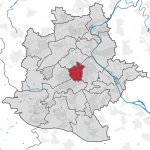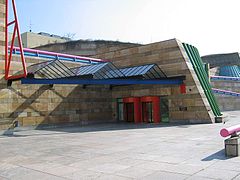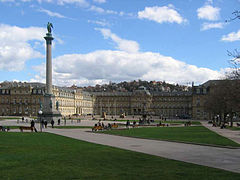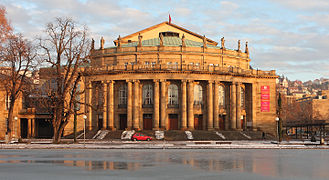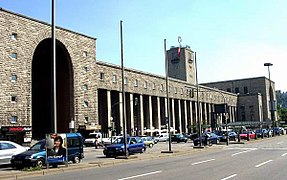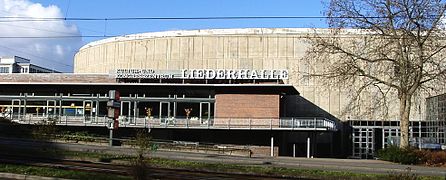Stuttgart-center
|
Stuttgart-Mitte District of the state capital Stuttgart |
|||||||||||||||||||||||||||||||||||||||||||||||||||
|---|---|---|---|---|---|---|---|---|---|---|---|---|---|---|---|---|---|---|---|---|---|---|---|---|---|---|---|---|---|---|---|---|---|---|---|---|---|---|---|---|---|---|---|---|---|---|---|---|---|---|---|
| City arms | City map | ||||||||||||||||||||||||||||||||||||||||||||||||||

|
|||||||||||||||||||||||||||||||||||||||||||||||||||
| List of districts of Stuttgart | |||||||||||||||||||||||||||||||||||||||||||||||||||
| Height : | 220- 300 u m. NHN | ||||||||||||||||||||||||||||||||||||||||||||||||||
| Population density : | 6,294 inhabitants per km² | ||||||||||||||||||||||||||||||||||||||||||||||||||
| Postal code : | 70173, 70174, 70178, 70182 | ||||||||||||||||||||||||||||||||||||||||||||||||||
| Area code : | 0711 | ||||||||||||||||||||||||||||||||||||||||||||||||||
| Address of the citizens' office: |
Eberhardstrasse 39 70173 Stuttgart |
||||||||||||||||||||||||||||||||||||||||||||||||||
| Website: | www.stuttgart.de | ||||||||||||||||||||||||||||||||||||||||||||||||||
| District Head: | Veronika Kienzle ( Greens ) | ||||||||||||||||||||||||||||||||||||||||||||||||||
|
|||||||||||||||||||||||||||||||||||||||||||||||||||
| Source: Stuttgart data compass | |||||||||||||||||||||||||||||||||||||||||||||||||||
Coordinates: 48 ° 47 ' N , 9 ° 11' E

Stuttgart-Mitte is the innermost district of the Baden-Württemberg state capital Stuttgart and lies between the districts of Stuttgart-North , -West , -East and -Süd .
geography
location
The Stuttgart-Mitte district lies on the bottom of the Stuttgart basin , the edge of which is formed by the four adjacent districts on a hillside.
Central area
The center of the district and the entire state capital is Königstrasse , one of the longest pedestrian zones in Europe, along which most of the well-known department stores and shops are represented. The representative center in the middle of Königstrasse is the Schlossplatz with the municipal art museum , the Königsbau and the New Palace . In the immediate vicinity is the Schillerplatz with the Old Castle ( Württembergisches Landesmuseum ) and the collegiate church . Another center, the former center of the old city, is the market square with the town hall .
Southern area
Further south follows the Tagblatt tower and, spatially separated by Hauptstätter Straße , the Leonhardskirche , as well as the bean and hay dough district .
Eastern area
To the east of the Schloßplatz, in the area of Konrad-Adenauer-Straße and the Upper Palace Garden , are the state parliament and the state theater , and on the other side of the street the state gallery , the Württemberg state library and the Wilhelmspalais , formerly the city library, now the city museum. The Konrad-Adenauer-Straße ( B 14 ) is on the one hand a cultural mile, on the other hand a busy city motorway.
Western area
On the western edge of the city center are the hospital district with the only partially rebuilt hospital church (in the "New Suburb") and a number of cultural institutions. Worth mentioning are the Liederhalle and the Linden Museum , in between the historic Hoppenlaufriedhof , then the Katharinenhospital and the banking district with the Friedrichsbau and the stock exchange . To the south of the Katharinenhospital on Kriegsbergstrasse there is a green area, the “Stadtgarten”. There, on Schellingstrasse and Keplerstrasse, are parts of the university , the former technical university, especially three high-rise buildings and the university library . Two of the skyscrapers are college buildings K1 and K2 near the main train station , the third is the Max Kade dormitory at the Liederhalle.
Northern area
The northern border of the district is the Europaviertel . Up until the 1980s, there was a freight station here, which used to be used to supply the city with goods. In the spring of 2002, the site began to be rebuilt.
The Kernerviertel around Kernerplatz, which is located north of the State Gallery, also belongs to this area.
Districts
The city district was created in its current form in 1956. At that time, the city district and the Stuttgart-Mitte district were identical. In 2001, the Stuttgart-Mitte district was redistributed into ten districts: Upper Schlossgarten , City Hall, Hospital District , University, Central Station, Klettplatz, Kernerviertel, Diemershalde, Dobel and Heusteigviertel .
The historic old town, which was severely affected in the Second World War and has changed significantly in its existing buildings - not in the course of the alleys - can be found mainly in the town hall district , to which the bean district and the tanner district were also added. Descriptions of the districts of Oberer Schlossgarten, Hospitalviertel, University and Klettplatz (main station) can be found in the Geography section . Kernerviertel, Diemershalde and Dobel are districts with a lot of residential buildings, the justice district (Urbanstrasse) extends into the Diemershalde.
With effect from July 1, 2007, the structure of the city in the Stuttgart-Mitte district was changed. The main statute had previously been changed accordingly by a resolution of the municipal council on March 22, 2007. In the urban district of Stuttgart-Mitte, a change in the boundary and associated renaming of two districts was made. Changes in the municipality:
- Main station district - until June 30, 2007 was the district of Klettplatz
- Europaviertel - until June 30, 2007 was the main station district.
history
In the area of what is now downtown Stuttgart, Duke Liudolf von Schwaben set up a horse stud farm (“Stuotengarten”) during the Hungarian invasions around 950. The location he chose was ideal for horse breeding due to the natural conditions of the valley basin, which is closed on three sides.
However, new archaeological excavations in the area of the collegiate church and the old castle show that it was not a matter of a greenfield foundation: a rural settlement had existed here at least since the late Merovingian period . A burial under the collegiate church supplements the sparse information about earlier finds of Merovingian graves in the city area. Remains of several pit houses from the Carolingian period are proven.
See also: History of Stuttgart
politics
The results of the municipal council elections in the city districts are decisive for the number of seats of the parties in the district councils. The 2019 local elections resulted in the percentage of votes shown in the diagram opposite and the following distribution of the 14 seats of the district advisory council:
- Greens : 4 seats
- CDU : 2 seats
- Fraktiongemeinschaft LINKE - SÖS - PIRATE - Animal Welfare Party : 2 seats
- SPD : 1 seat
- FDP : 1 seat
- AfD : 1
- Free voters : 1 seat
- PULSE: 2 seats.
Veronika Kienzle (Greens) is the honorary district head of the Stuttgart-Mitte district.
Culture and sights
theatre

- Big house , opera house, built 1907–1912 by architect Max Littmann
- Small house , theater, built 1959–1962
- Old playhouse
- Renitenztheater (cabaret stage)
- Friedrichsbau Varieté (1994-2014, relocated to the Pragsattel)
Museums
- State Gallery Stuttgart
- municipal art museum Stuttgart
- Linden Museum , State Museum of Ethnology . The name of the Linden Museum goes back to Karl von Linden . He was chairman of the Württemberg Association for Commercial Geography. In 1889 what was originally the Museum of Commerce and Geography was converted into today's Ethnographic Museum.
- Württembergisches Landesmuseum (in the old castle)
- "Hotel Silber" - former headquarters of the Gestapo. The museum as a place of remembrance for the victims of National Socialism is still under construction.

Parks / cemeteries
- The Hoppenlaufriedhof is one of the oldest cemeteries in Stuttgart. It was laid out in 1626 and expanded to around 7000 graves by 1824 with a Jewish burial site. No funerals have taken place there since 1880. In 1961 the cemetery was prepared as a park on the occasion of the 1961 Federal Horticultural Show. The entire park is still interesting today and represents an "island of calm" in the big city. a. the graves of Johann Friedrich Cotta , Wilhelm Hauff , Johann Heinrich Dannecker , Johann Gottfried Pahl , Christian Friedrich Daniel Schubart , Gustav Schwab and Emilie Zumsteeg .
Buildings
- The old castle was a moated castle in the 13th century. Since the 14th century it has been the headquarters of the Counts and Dukes of Württemberg.
- Since 1970 there has been a memorial to all victims of National Socialism on Karlsplatz , designed by the sculptor Elmar Daucher , with a text by the philosopher Ernst Bloch .
- The New Palace , a late Baroque building from the years 1746–1797 and 1805–1807, served as the residence for Duke Carl Eugen and his successors; today two ministries.
- Königsbau : The classicist pillar building was built from 1856 to 1860 by Knapp and Christian Friedrich Leins as a concert, ball and commercial building. In 1958/59 the reconstruction took place; Today it serves as a commercial building with a 135 meter long colonnade.
- The Carl Zeiss Planetarium in the Schlossgarten was built from 1975 to 1977 according to plans by architect Beck-Erlang and opened on April 22, 1977.
- The Haus der Wirtschaft Baden-Württemberg with the Stuttgart Design Center is still known to many Stuttgarters as the state trade office.
- The Stuttgart Main : opened in 1922, very close to town, the previous building, also terminus station, was right when Königsbau at today Bolzstraße. As a result of the Stuttgart 21 project , which has reached its implementation phase, it is being completely rebuilt, with all tracks disappearing in an underground through station.
- Hegelhaus , the birthplace of the philosopher
- Schellenturm , a sparse remnant of the Stuttgart city wall
- Tagblatt-Turm , the first high-rise building in Germany made of exposed concrete (61 m high) by architect Ernst Otto Oßwald
- The famous Schocken department store, which was built by architect Erich Mendelsohn in 1926–1928 , stood directly opposite until 1960 . The department store, which was only slightly damaged in the Second World War and which, together with the Tagblatt Tower, formed an impressive ensemble of modern architecture, was approved for demolition by the city of Stuttgart in 1960 under international protest. In his place, Egon Eiermann built a hoarding department store (now Galeria Kaufhof) with an abstract building facade made of hydrangea tiles .
Ruin of the new pleasure house
- The Liederhalle was inaugurated as a concert hall in 1956 (architects: Rolf Gutbrod and Adolf Abel ) on the site of the previous building built in 1864 by Christian Friedrich von Leins , which was destroyed in 1944. The listed building is part of the Kultur- und Kongresszentrum Liederhalle (KKL).
- Stuttgart market hall , built 1911-14 by architect Martin Elsaesser (Art Nouveau)
- The art building on Schloßplatz was built in 1912–13 by the architect Theodor Fischer . It stands on the site of the court theater that burned down in 1902, the core of which in turn rests on the New Lusthaus, built by master builder Georg Beer from 1583 to 1593 . The Württembergischer Kunstverein is located in this striking building, the domed roof of which is crowned by a golden stag by Ludwig Habich . Since the municipal gallery moved out, the building has mainly been used for special exhibitions.
- Former orphanage on Charlottenplatz with the ifa gallery in Stuttgart
- The Wilhelmspalais on Charlottenplatz, which until 2011 housed the Stuttgart Central Library, was built by Giovanni Salucci from 1834 to 1840 for two princesses, the eldest daughters of King Wilhelm I of Württemberg . The house later served as the residence of the last Württemberg King Wilhelm II . On November 9, 1918, revolutionaries occupied the house and the king abdicated.
- Friedrichsbau on the site of the historic Friedrichsbau Theater
- The Hans-im-Glück-Brunnen is a fairy tale fountain in the old town and a popular meeting place for the pub and party scene.
Churches
- The collegiate church in the old town in the immediate vicinity of the old castle is the main church of the Evangelical Church in Württemberg . The lower part of the south tower is the only surviving structural evidence of the Staufer era in Stuttgart. With its two unequal towers, it is one of the city's landmarks. The first construction period dates from around 1170. In its remaining parts, however, the building dates from the High and Late Gothic .
After heavy destruction in the Second World War, it was decided to restore the interior and exterior of the church in a simplified manner.
More than 100 members of the House of Württemberg - dukes, kings, princes, children - have found their final resting place in the crypt under the choir and the sacristy. The famous statues of Counts by Sem Schlör , which were erected on the north wall of the choir in the 16th century, are a reminder of this .
- After the collegiate church, the Leonhardskirche in the southern part of Stuttgart's old town known as the Bohnenviertel is the second oldest church in the city. In 1337 it was founded in the form of a chapel in the open field at the gates of the city. Today's construction began in 1408 and was largely completed in 1466. After the destruction in World War II, the church, like the collegiate church, was only rebuilt in a simplified manner. On the square behind the choir is a copy of the late Gothic crucifixion group by Hans Seyfer from 1501. The social project Vesperkirche Stuttgart has been carried out here since 1995 .
- Hospital church , built between 1471 and 1493 by master builder Aberlin Jörg for the Dominican order. In the district around the only partially rebuilt church there are many institutions of the Württemberg regional church .
- St. Eberhard Cathedral, co-cathedral of the Rottenburg-Stuttgart diocese. Built 1808–1811 by the architect Nikolaus Friedrich von Thouret ; Destroyed by bombing in 1944. Reconstruction 1953–1955 by the architect Hugo Schloesser. Inside a large altar mosaic depicting Christ and the wise and foolish virgins , also a gilded Pietà and, since 1982, an Albiez organ, the largest church musical instrument in Stuttgart.
- The Church of St. Maria was built in 1871–1879 by the architect Joseph von Egle based on the model of the early Gothic Elisabeth Church in Marburg an der Lahn. The large church with two towers burned down during World War II in 1943 and was restored in 1948/49. After the St. Eberhard Cathedral, it was the second Catholic parish church of the then Württemberg-Protestant royal residence city of Stuttgart. The church of St. Maria on Tübinger Strasse is just under in the Stuttgart-Süd district.
Celebrations / events
- Bean quarter festival
- Executioner's Festival
- Hamburg fish market
- Summer festival in August
- Stuttgart Christmas Market
- Stuttgart wine village
- International Children's Festival "23 Nisan"
Literature / homeland books
- State capital Stuttgart, Statistical Office (Ed.): City district profile center . Stuttgart 2006.
- The bean quarter . In: Eugen Dolmetsch: Pictures from Old Stuttgart. Retold and self-experience. Stuttgart 1930, pages 113-139.
- Georg Friedrich Kempter: The Stuttgart bean district. In: Denkmalpflege in Baden-Württemberg , 6th year 1977, issue 2, pp. 86-92. ( PDF; 9.8 MB )
Web links
- Bean district Stuttgart
- Bean quarters
- Stuttgart city panoramas - interactive 360 ° panoramas
- Kultur- und Kongresszentrum Liederhalle
- Linden Museum
- District portal
Individual evidence
- ↑ The Europaviertel . State capital Stuttgart. Archived from the original on July 13, 2010. Info: The archive link was inserted automatically and has not yet been checked. Please check the original and archive link according to the instructions and then remove this notice. Retrieved March 9, 2010.
- ^ Office building of the Landesbank Baden-Württemberg with City Tower . State capital Stuttgart. Archived from the original on November 24, 2012. Info: The archive link was automatically inserted and has not yet been checked. Please check the original and archive link according to the instructions and then remove this notice. Retrieved March 9, 2010.
- ^ Federal Agency for Civic Education : Memorials for the Victims of National Socialism. A documentation. Volume 1: Ulrike Puvogel, Martin Stankowski: Baden-Württemberg, Bavaria, Bremen, Hamburg, Hesse, Lower Saxony, North Rhine-Westphalia, Rhineland-Palatinate, Saarland, Schleswig-Holstein. 2nd revised and expanded edition. Federal Agency for Political Education, Bonn 1995, ISBN 3-89331-208-0 , p. 87.
- ↑ St. Eberhard Cathedral ( Memento of the original from February 25, 2014 in the Internet Archive ) Info: The archive link was inserted automatically and has not yet been checked. Please check the original and archive link according to the instructions and then remove this notice. Sights at stuttgarter-nachrichten.de.
